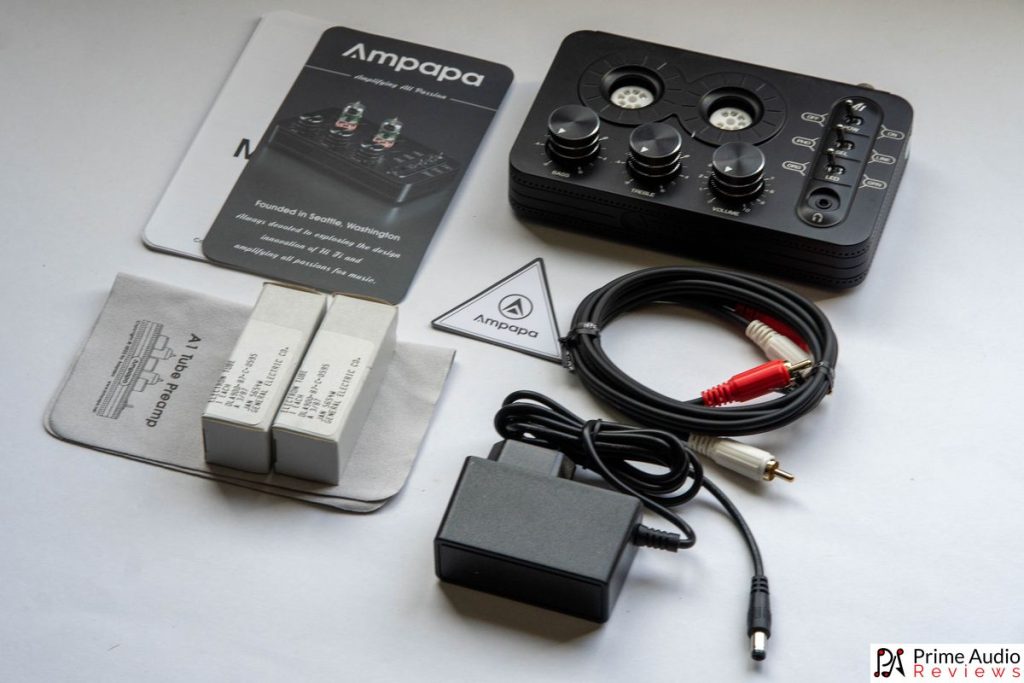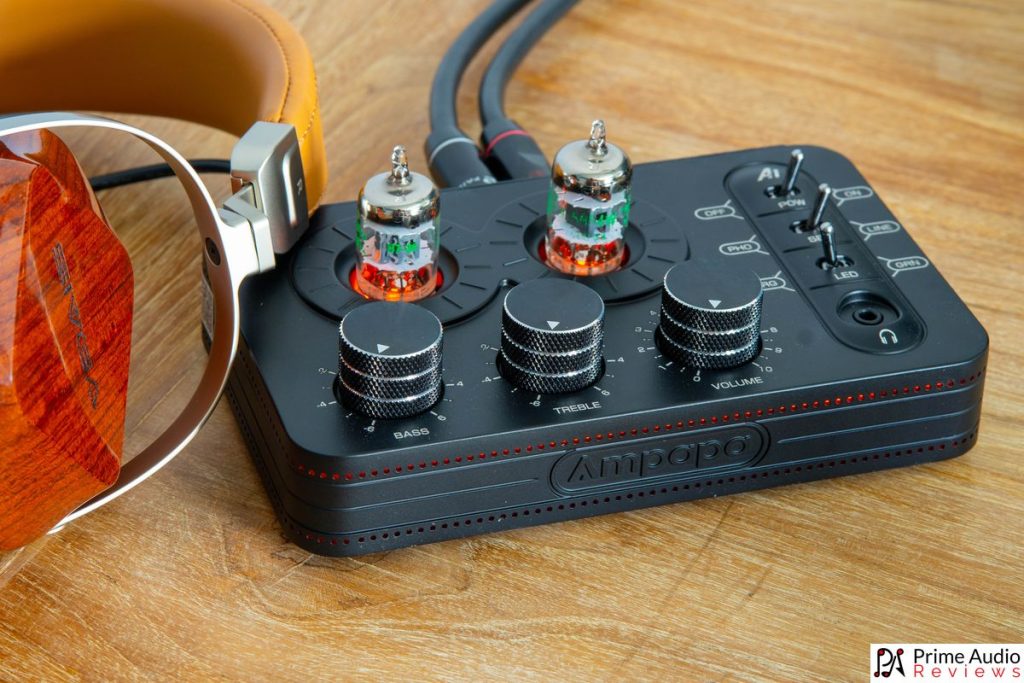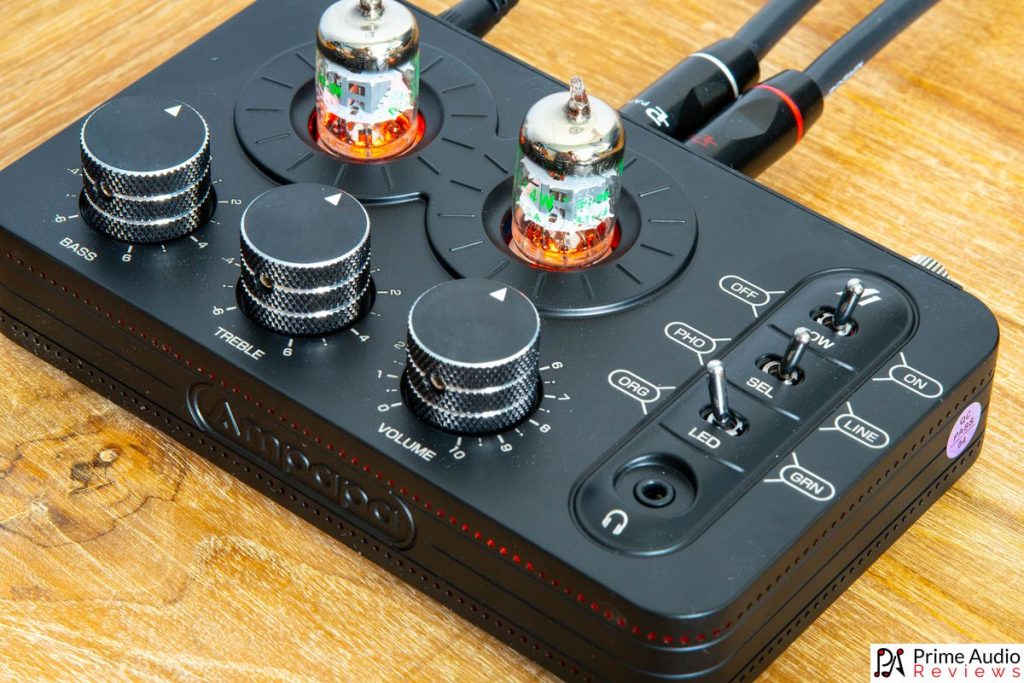The Ampapa A1 is a vacuum tube phono preamp, headphone amp and HiFi preamp. It features dual JAN GE5654 vacuum tubes, tone controls and an all-metal chassis. It’s priced at $139.
Disclaimer: This sample was provided by Ampapa for an honest review. All observations and opinions here are my own based on my experience with the product.
Ampapa A1


What’s in the Box
- Ampapa A1
- 2x JAN GE5654 vacuum tubes
- Power adapter
- Cleaning cloth
- RCA cable
- User manual
- Warranty card


Design & Features
I got a bit of a surprise as soon as I laid my hands on the A1. Knowing the MSRP, I expected a flimsy little thing with a thin aluminium frame. But nope. This thing feels really nicely built; it’s all-metal, including the switches and the knurled aluminium knobs.
The other thing that surprised me was how good this little amp looks in person. It’s a genuinely handsome little device with perforated side panels and white printed labels on its matte black finish.
Those perforated side panels help to dissipate any heat inside the device but they have another function too. You see, there are a series of orange and green LEDs inside the chassis that glow when the unit is turned on. You can choose either orange or green or you can turn the LEDs off altogether. This is a neat little feature that adds even more character to the A1’s aesthetic.

There are 3 dials at the front of the chassis for bass and treble tone controls plus the volume. The dials are notched and have a satisfying amount of resistance when you turn them.
The 3 switches on the unit are for Power On/Off, Phono/RCA Input switch and LED light controls. Just below the switches is a 3.5mm single-ended headphone output. On the rear panel, we find the MM Phono/RCA inputs and the RCA output.
Sound Performance
So why tubes? Well, unlike modern transistor-based amplifiers, tube amps are considered to have a warmer and more analogue sound signature – something that can be desirable in this age of digital dominance. They add even harmonics that are even-numbered multiples of the fundamental frequencies that often result in a richer sound.
Yes, the Ampapa A1 has tubes: 2 tiny little ones. Yes, they do alter the sound but not as drastically as you might think. What the A1 does is put a little touch of smoothness and earthiness into the sound.
If you’re looking for absolute transparency, tubes probably aren’t the best choice for you. But if you want a little added character in your music then you’re in the right place. Having said that, the A1’s sound is still clear and near transparent. I wouldn’t call it a warm sound but, the second-order harmonics distortion (the good kind of distortion) created by the A1 adds dimension to vocals and instruments.
The A1 has a clean sound and importantly, one with almost zero audible noise floor. I wouldn’t recommend this amp for very sensitive IEMs like the Campfire Andromeda, but for regular IEMs and especially headphones such as the Beyerdynamic DT990 Pro or SIVGA Oriole, the A1 is the perfect candidate.

I found the A1 also works great with my NHT C3 speakers. The C3 are a precise and tight speaker and adding a little extra grittiness via tubes gives them some added fullness and texture.
The A1 makes the sound airier and creates a larger soundstage. Vocals and instruments take on a larger sense of scale and the midrange in general is presented slightly more forward. The soundstage is stable albeit not as strictly organized as some solid-state amps like the Topping L30 II.
You can fine-tune the sound with the bass and treble tone controls which adds versatility and compatibility to the A1. As is often the case with tone controls on a budget amp, you don’t want to swing the knobs too far in either direction. I found that rotating more than 45 degrees from the centre things start to sound muddy (bass) or fuzzy (treble). But if you make subtle adjustments the tone controls work really well. It’s perfect if you want to fill the sound out or tighten up the lows (bass) or add/curtail brightness (treble).
Listen to Soen’s “Gods Acre” with the A1 and the electric guitars sound crunchy and textured. The vocals are smooth but vibrant and firmly occupy the centre of the stage. The soundstage is wider than usual but note density is intact and the centre image is stable. There’s extra air surrounding the hi-hats and crash cymbals which sound slightly softer and smoother.
The acoustic guitar at the beginning of Almunia’s “Follow What You Are” sounds spacious and crisp. When the kick drums come in they feel weighted and assertive, as if you were in the room with the drummer. Despite its smoother presentation, the A1 still sounds clear and focused.

Verdict
The Ampapa A1 is nicely built and has an excellent overall design. The aluminium chassis and the knurled knobs exude a quality unexpected at this price. In addition, the sound is clear and precise, lending a touch of analogue smoothness to music while keeping details intact. For its first product, Ampapa has done a great job with the A1 and I look forward to seeing what they do next. Recommended.

Specifications
| Audio input | Phono MM / Stereo RCA |
| Audio output | Stereo RCA / 3.5mm Headphone Jack |
| Input level | 0.775V RMS (RCA); 0.005V RMS (Phono) |
| Frequency response | 20Hz-20KHz (±0.5dB) (RCA); Ref to RIAA +/-2dB (Phono) |
| Headphone output power | 125mW (32Ω)/62.5mW(64Ω)/30mW(128Ω) |
| Headphone impedance range | 16-300Ω |
| THD | ≤0.1% |
| Output level | 1.5V RMS (RCA); 0.6V RMS (Phono) |
| S/N ratio | ≥106dB (RCA); ≥80dB(Phono) |
| Working voltage | DC 12V(≥1.5A) |
| Package weight | 900g / 1.98lb |
| Package dimensions (W*D*H) | 260*145*78mm / 10.24*5.71*3.07in |


